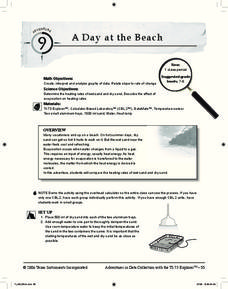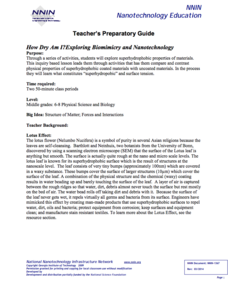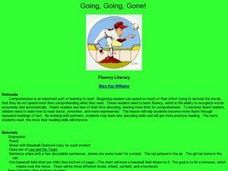Curated OER
A Day at the Beach
Help learners determine the rate of change for the temperature of sand. They will collect data on the temperature of wet and dry sand over time with a heat lamp overhead. Then make a scatter plot of the data and find a linear model to...
Curated OER
Dripping Wet or Dry as a Bone?
Students use a sponge and water model to explore the concept of relative humidity and create a percent scale. They define humidity and saturation, build a simple humidity/saturation model, collect, predict and interpret data, and create...
National Nanotechnology Infrastructure Network
How Dry am I? Exploring Biomimicry and Nanotechnology
Help your classes feel like they can walk on water! An engaging inquiry-based lesson has young scholars experiment with different surface coatings. They make observations about their properties and how they relate to the surface tension...
Curated OER
What Does the Inside of a Seed Look Like?
First graders study seeds. In this biology lesson, 1st graders observe the differences between dry and wet seeds and draw what is inside a seed after peeling off the outer coat of one of the seeds.
Curated OER
Going, Going, Gone!
Sixth graders use the scientific method to test variables of evaporation. In this evaporation lesson plan, 6th graders test a wet handprint on a paper towel and relate this experiment to weather conditions.
Curated OER
Artist in Schools Program
Students explore the medium of watercolor paints. They observe basic watercolor painting techniques (such as wet-on-wet, wet-on-dry and dry-on-dry). Then students experiment with these techniques on small squares of watercolor paper.
Curated OER
Observing Rocks
Fifth graders explore the various properties of earth and rocks. They play "Twenty Questions" with the teacher, and analyze a rock using a magnifying glass. They record their rock observations and list the differences between the wet...
Cornell University
Making a Battery
Don't be shocked when your class has a blast making their own batteries! Science scholars examine a dry cell battery, then design and construct a wet cell battery. The activity guides them through the parts of a battery, the variables...
Curated OER
#21 Films, Fibers, and Solubility
Students are introduced to how the differences in solubility of materials are used in the manufacture of fibers and films. They are also introduced to the various processes used to make films and fibers. Pupils prepare fibers using wet...
Curated OER
Air Pollution Control
Students examine two devices used to clean up the air waste stream before it enters the atmosphere. They construct and use a wet scrubber and an electrostatic precipitator, and answer discussion questions.
UNESCO
The Water Cycle
Young scientists get their feet wet as they learn about the water cycle in this series of activities. Whether they are observing how evaporation causes puddles to dry up, or how plants put water into the atmosphere through transpiration,...
Curated OER
Tissue Paper Butterfly
Creating butterfly art is as simple as 1-2-3. Kids cut coffee filters into butterfly shapes. Next, they wet and place squares of tissue paper onto the filters. Fifteen minutes later, they lift the tissue to reveal a colorful pattern...
Curated OER
Sow Bug Habitats
Students conduct an experiment to determine what type of environment sow bugs prefer. They use petri dishes with partially wet paper towels to assess whether they prefer wet or dry habitats.
Curated OER
Building a Psychrometer
Students create psychrometers to measure the humidity of the air. In this meteorology lesson, students make a wet-bulb thermomter and place it next to a dry-bulb thermometer to measure the relative humidity in the room.
Curated OER
Micros-organisms
Sixth graders examine mold with a microscope. In this micro-organisms lesson, 6th graders use teacher-prepared mold samples to prepare a wet-mount slide and examine the mold under a microscope then draw and label what they see.
Curated OER
Capillary Action
Students experiment with capillary action. Capillary action enables soil moisture to move in any direction within the soil as water moves from wet areas to drier areas. Capillary rise of water occurs especially in and regions where...
Curated OER
Characteristics of Living Things
Student use the scientific method to experiment with worms. In this characteristics of living things lesson, students predict and examine the reactions of worms to dry and wet soil. Students share their findings.
Curated OER
Wet-Dry Bulb Hygrometers: Measuring Relative Humidity and Apparent Temperature
Students work in groups of 4 for the activity/activity part of this exercise. They know that clouds are formed by the condensation of water vapor, affect weather and climate. Also that global patterns of atmospheric movement influence...
Curated OER
How Much Soil is There?
Students examine that all living things depend on soil to live. In this science lesson, students pretend that an apple is planet Earth. Students cut the apple to represent the portions of Earth with the last section representing soil.
Curated OER
Sweat Your Socks Off
Fourth graders explore evaporation by conducting an experiment. In this water properties lesson, 4th graders examine the differences between two socks that get wet, one which is placed in front of a fan. Students discuss why the sock...
Curated OER
Terrestrial Hi-Lo Hunt
Students assess environmental factors. In this environmental factors lesson, students explore their surroundings identifying warm and cool spots, dry and wet areas, and determining the warmest and coolest areas. Students analyze their...
Curated OER
Behold the Mold!
Students explore how mold grows on various food items. In this mold lesson plan, students predict how mold will grow on dry vs. wet food items, and chart their observations daily. Children develop a summary to aid them in a summative...
Curated OER
How Effective is Perspiration at Cooling?
Students collect data on the cooling of water in two different test tubes, one that is wrapped in wet newspaper and one in dry newspaper. They then relate this cooling effect to the body's perspiration.
Curated OER
Life in Extreme Environments
Pupils compare and contrast local environments with the extreme environment of the Dry Valleys, Antarctica. Students explore and gain knowledge of the adaptations organisms use to survive extreme conditions and the diverse conditions...
Other popular searches
- Wet and Dry Environments
- Project Wet and Dry
- Wet and Dry Concepts
- Wet and Dry Climates
- Wet and Dry Write
- Wet and Dry Enviroments
- Environment Wet and Dry
- Dry Cell Wet Cell
- Wet and Dry Vocabulary
- Wet and Dry Weather
- Wet and Dry Environments Unit
- Wet and Dry Enviroenments

























